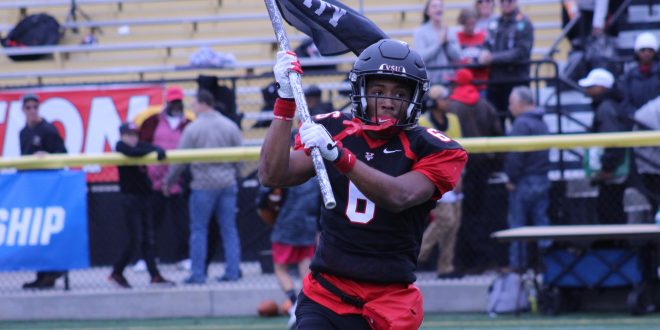The Valdosta State Blazers are now national champions and the kings of Division II football after Head Coach Kerwin Bell’s third season.
This football program seemed to have transformed into a powerhouse overnight following a floundering 5-4 finish in 2017, and to their credit, they kind of did.
At the end 2017, Bell knew a few things: Rogan Wells was his quarterback for the future, he needed more push both sides of the line, more speed, and most importantly, he knew he had a young team.
Since the end of that year, the dawn of the Bell era began.
What people may not have noticed this season is the progressions returning players made.
“We knew that if we had to be better than 5-4 that we needed to work hard in the weight room and on the field and we did that,” Wells said. “Like every day, in the winter, in the spring, and especially in the summer. We had about 50 people down in Valdosta in the summer so, we were working really hard and it pays off.”
Wells wrapped up this season as the Harlon Hill Trophy runner-up and defeated the trophy winner in the national championship. But just last year, he wasn’t referred to as ‘Rogan Hill.’
2017 was the coming out parade for Wells. It started off rocky while he gained control of the offense after Adam Robles went down with an injury. Once he settled in, Wells started to shine and VSU won four out of their last five games, averaging just under 40 points per game.
Wells continued to work his tail off in the offseason and progressed even more. His arm, pocket awareness, and all-around ability to play quarterback escalated to another level in just one year. Compared to 2017, Wells improved his passing yards per game from 156.11 yards to 219.64 and increased his passing touchdowns by 26. Also having a former Florida Gator quarterback as his head coach is a nice commodity to have.
The Blazer’s top three receivers this year was the sophomore trio of Brian Saunds, Lio’undre Gallimore, and Kenny Benjamin. Saunds and Benjamin received plenty of opportunities in 2017 as they both saw the field as freshmen. Saunds led the team in touchdown grabs with 6 and Benjamin quickly became a fan favorite with his ability to make defenders look silly.
This season Saunds repeated as the team’s touchdowns leader with 10, and Benjamin continued to shift his way around the field, but the breakout receiver this go around was Gallimore. Gallimore finished with 900 yards, the most receiving yards on the team, and 9 touchdowns with an average of 25 yards per catch.
Either one of these receivers can be the hot hand on any night, so it’s hard to say who the star is. The smart thing for opponents to do is game plan for all of them, but that’s way easier said than done.
In the backfield, running back Jamar Thompkins showed out after being redshirted last year and he relieved Wells from being the primary ball carrier. His first active season resulted in 1,339 yards, 9 touchdowns, and averaged 9.7 yards per carry. The numbers speak for themselves, Thompkins is a big-time playmaker.
Notable players in the trenches like offensive linemen Jeremy King and Brandon Kemp combined with defensive linemen Joseph Mazone, Guito Ervilus, and Iseoluwapo Jegede were all vital pieces to this year’s title run.
In the secondary, seniors Stephen Denmark and Raymond Palmer had terrific seasons and finally captured that elusive national title in their final game. 2018 All-American honoree, Ravarius Rivers, had an outstanding year at safety after being a redshirt last year. He was all over the field every game, racking up 74 tackles and 2 interceptions.
But it didn’t stop there of course, in addition to the returning players improving on their game, Coach Bell filled holes and added depth to his roster through recruiting.
His number one priority during recruitment was investing in the trenches.
Bell already had Kemp, now a two-time All-GSC offensive tackle, and King, the best offensive linemen in the nation this year on his line. In addition to those studs, Bell added transfers: Ralph Singleton, Adonis Sealey, and LaVonne Gauthney to complete his line.
King, Sealey, and Gauthney received First Team All-GSC honors this year and Kemp earned a Second Team All-GSC spot. Now that they’re champions, it’s hard to dispute that they were the best O-line in DII.
On the D-line, Bell brought in senior transfer Darius Smalls. Smalls doesn’t have stats that tell you his true impact, but Smalls was frequently the biggest man on the line and warranted a double team every snap he was on the field. His presence alone clogged running lanes and even effected the pass because two linemen had to keep a hand on him.
After Bell got what he needed in the trenches, he went to the next priority on his recruiting checklist.
Speed.
Bell sought after David White, a fast receiver that can get behind secondaries and use his 6’3 frame for jump balls. Another addition was Michael Henderson, another speedy receiver that broke his high school’s 200m record in 21.75 seconds. Both White and Henderson had solid seasons, and each received GSC Freshman of the Week honors this year.
Ivory Durham, the high school phenom from Jacksonville graduated from high school as the third all-time for career passing yards leader in Northeast Florida. Bell brought him in as the backup for Wells, but Durham is such an explosive athlete that he has lined up at quarterback, receiver, and even punt returner. This kid has a bright future in this program and it’s going to be exciting to see.
Another notable addition was Seth McGill, a freshman running back from the 305 area code that has been an instant impact for VSU. McGill brings a versatile dynamic by being able to receive as well, he averaged 9.58 yards per reception while totaling 733 rushing yards for 10 touchdowns.
Thompkins and McGill both had breakout campaigns that forced last year’s feature back, Quahlin Patterson, to rotate with them. The Blazers now have three running backs capable of starting and shouldering the load at that position.
Defensively, freshman standout Jameon Gaskin has already solidified himself as one of the top defensive players of the Black Swarm. He relentlessly runs on a high motor and led the team in tackles this year with 75 and was also third on the team in sacks with four.
Coach Bell and company recruited a perfect mix of transfers and freshmen that fit their fast-paced style like a glove, and some of them proved to be instant impacts.
The best thing is, that’s not all the notable players on this team, not even close. There are plenty more that I haven’t mentioned because this column would turn into an essay if I did.
We all know Head Coach Bell is the mastermind behind this program, and the players did most of the work. But this whole ride that put them in the history books wouldn’t have been possible without Bell’s two coordinators.
Not enough credit could be given to defensive coordinator Danny Verpaele and his Black Swarm. The Swarm has always been a good defense under Verpaele but this year the defense was on a mission. The Black Swarm led the nation in defensive touchdowns with 7 and was tied for No.11 for most turnovers gained with 27.
Bell said this about his team while the Blazers were handed over the DII National Championship trophy:
“I told my defense around the middle of the year, we get all the publicity on offense, but if we’re going to win a championship it’s because we got a championship defense.”
A big reason for the publicity was because of Coach Bell’s son, Kade Bell, who took over as offensive coordinator before the season and couldn’t have done a better job. From being the quarterback’s coach just last year, he has now pushed VSU’s attack to a new level that the GSC has never seen before.
When Bell posts anything regarding the offense on social media, it’s typically followed with #LiveOnTheEdge and #PlayFastScoreFaster. Those aren’t just hashtag, they describe exactly how the Blazers play ball. It’s fast, aggressive, all the time, and in just his first year as offensive coordinator, Bell made VSU the top scoring offense in the nation with a 52 point per game average.
The Valdosta State football program had a historical season for sure. One of the best, if not the best season in VSU’s history. Now that they’re champions, they have a few months to brag, but then it’s back to business. Back at the grind to get better, and back to the recruiting board.
The cycle will repeat itself next year, and the Blazer’s track record says that they’ll only get better from it.
Written by Joshua Miller, Social Media Editor. Photo by Juston Lewis, Editor-in-chief.
For more sports click here.
 The Spectator The independent student newspaper of Valdosta State University
The Spectator The independent student newspaper of Valdosta State University







